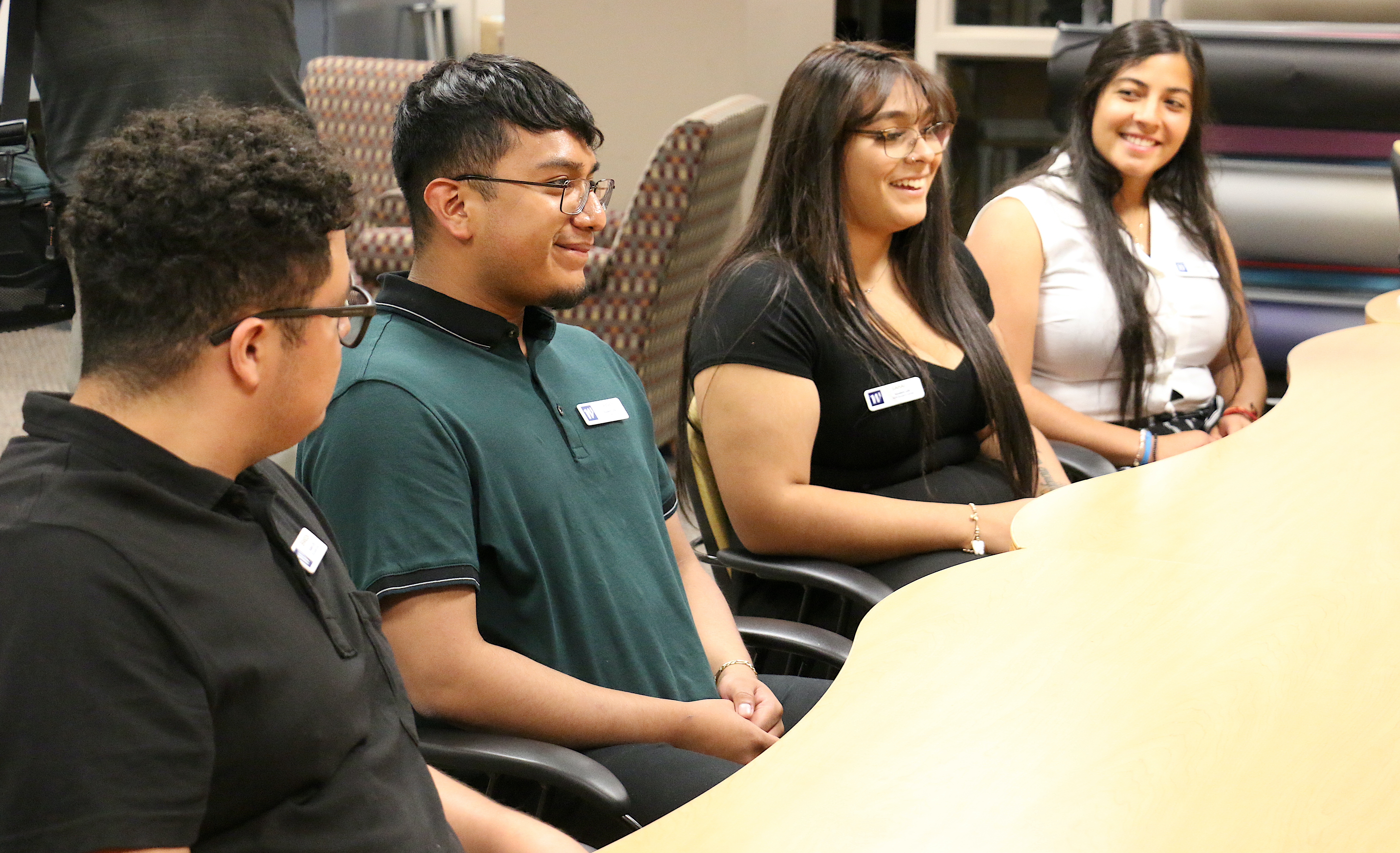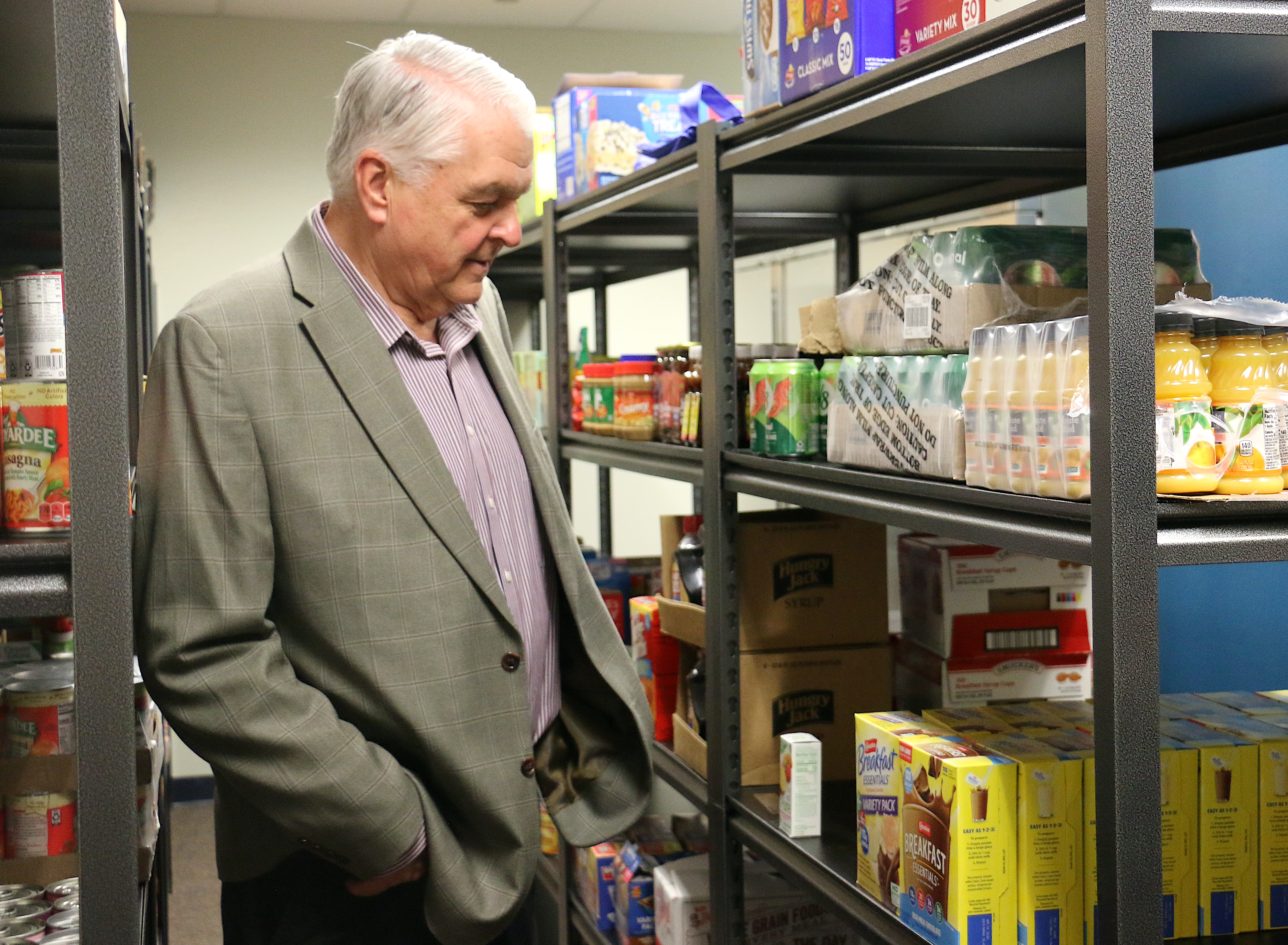Gov. Steve Sisolak had an opportunity Tuesday to take a drive down Carson Street in an L3 Harris model simulator at Western Nevada College as part of the campus’ commercial driver’s license program. The program earlier this year received a $400,000 grant from the Governor’s Office of Economic Development Board.
Photo by Jessica Garcia.
Gov. Steve Sisolak hasn’t been behind the wheel for a while, so as he sat in Western Nevada College’s commercial driving simulator Tuesday, he was very cautious driving down Carson Street or on unpaved roads elsewhere.
Staff members praised Sisolak for using his turn signal, although he chuckled when they snickered if he got a flat tire or drove a little slower. WNC Instructor Lauren Moore restored his tire with a click of a mouse button, and the governor kept on trucking in the lifelike L3 Harris model of an 18-wheeler. He was impressed by the virtual experience.
School is back in session this week for WNC, and Tuesday was an opportunity to see how several of WNC’s programs are benefiting from local funding to address several critical workforce needs in the state.
The driving simulator was Sisolak’s first stop on his tour of the Carson City campus. The program earlier this year received a $400,000 grant from the Governor’s Office of Economic Development Board to address the shortage of commercial drivers. Students interested in becoming licensed Class A drivers can learn skills to safely drive commercial vehicles including buses or trucks and focus on basic control and operating trucks and trailers. The class is 85 percent hands-on and 15 percent classroom instruction. Jessica Garcia / Nevada Appeal
Jessica Garcia / Nevada Appeal
Gov. Steve Sisolak, second from left, learns about a new Laerdal mannequin provided by a Governor’s Office of Science, Innovation and Technology grant to train Emergency Medical Services students in emergency situations. Paramedicine Program coordinator Terry Mendez, far left, and WNC medical director Dale Carrison, center, discusses the mannequin’s capabilities and how students interact with it as Laerdal field service engineer Taylor Morgan demonstrates how it works.
Continuing Education Coordinator Lauren Moore said two full-time instructors run two trucks out of Carson City and Fallon.
“Employers are just knocking on my door every day hiring graduates,” she said. “We can’t put them through fast enough.”
Before the grant, WNC’s program was accepting six students at a time to complete 100 hours of training. GOED’s grant will now allow the college to double its enrollment per cycle.
Instructors review driving records, physical limitations, assist with the necessary screenings and help students through their class schedules, needs or requests. The cost generally is about $3,900 with fees to cover Department of Motor Vehicles permits or Department of Transportation screenings.
Sisolak also visited the school’s Wildcat Reserve Food Pantry, overseen by the student government in the Dini Student Center, and stocked through donations from NV Energy, Visiting Angels and University Police Services.
Heather Rikalo, Student Life coordinator, demonstrated to Sisolak shelves in the pantry lined with non-perishable food items such as Spaghetti-Os. The service area began in fall 2020, and Rikalo said the pantry was inspired by a past student body president who wanted to help vulnerable or food-insecure students without fear of humiliation from others. A student needs result in 2020 indicated nearly 30% of respondents had been food insecure within the past 30 days, 25% were housing insecure within the past year and at least 38% experienced both vulnerabilities.
Items collected are placed in grab-and-go baskets. Jessica Garcia / Nevada Appeal
Jessica Garcia / Nevada Appeal
Western Nevada College students Brandon Salazar Garcia, left, Abner Perez, Sarai Salas and Gisela Munoz speak with Gov. Steve Sisolak about their experience on campus Tuesday.
“We’re increasing usage all the time, and this semester has been super special,” Rikalo told Sisolak. “It’s our second day in and we already have students handing in orders.”
“Removing stigmas is terrific for the kids, too,” he said.
Sisolak spoke with student leaders including incoming student body president Suzanna Stankute, Gisela Munoz, Abner Perez, Sarai Salas and Brandon Salazar Garcia about campus life.
Also part of the tour was a stop into the college’s Paramedicine Certificate Program to visit an EMS108 course, a class that helps students learn basic emergency procedures and skills. Participants treat patients in sudden illness or injury, use automatic external defibrillation devices and give continuing care during ambulance transportation to an emergency room. Instructor Melissa Leist and EMS medical director Dale Carrison accompanied Sisolak and his staff into the class as the governor asked what interested students about going into the emergency medical services field or what they hoped to do after graduating, with some still undecided.
The Governor’s Office of Science, Innovation and Technology has provided more than $500,000 to WNC for the Paramedicine Certificate Program to support the growth of a rural health care workforce. Additional funds this year allowed the college to purchase EMS high fidelity simulation mannequins first created for resuscitation training by international company Laerdal, headquartered in Norway.
WNC Paramedicine Program Coordinator Terry Mendez, with WNC since 2019, said brand new program, we have before demonstrated working adult and baby mannequins and their functions, with both capable of lifelike breathing, blinking, sweating, crying and urination capabilities. Students can perform intubation, insert air into the mannequins’ stomachs and interact with them to treat any symptoms or results from any condition that occurs, Mendez said.
“If they don’t treat him right, you’ll actually watch (the monitoring) on these screens and you’ll watch him go down until he goes into arrest,” he told Sisolak. “I’ve used these in ambulances, on helicopters. They’re phenomenal.”
At the end of the tour, Sisolak told the Appeal he was pleased with the projects and opportunities happening in higher education to provide young adults a pathway to skill development but said it’s still important to keep acquiring more funding.
“To me, it’s not an issue that these kids get their degree, whether it’s an associate, bachelor’s, master’s or PhDs,” he said. “It’s that they get training and the skill set to be able to support themselves and their families. That’s extremely important, and I’ve tried to focus on that. Even when I was on the (Nevada State) Board of Regents) for 10 years, if you can come in if it was a three-month course, and you suddenly become qualified to get a job, that’s a great thing.”
Sisolak said encouraging more workers where there are shortages in the EMS fields will take getting into the middle and high schools to interest students at an early age.
“Kids at that age are usually interested in the compensation and those are good-paying jobs that they can get into without having to take on a four-year degree and the burden of the debt that can be associated with a four-year degree,” he said. Jessica Garcia / Nevada Appeal
Jessica Garcia / Nevada Appeal
Gov. Steve Sisolak speaks with Western Nevada College students Suzanna Stankute, incoming student body president, back right, and Gisela Munoz, front left, Sarai Salas, Abner Perez and Brandon Salazar Garcia about their experience on campus Tuesday.
Dalpe said the EMS and paramedic mannequins are “really cool” by becoming alive with a computer.
“By using simulation, we allow students to get more time in dealing with and practicing symptoms and then they get out in ridealongs with a paramedic, and then they’ll have a real patient and can get the experience and can troubleshoot and think on their feet and help people out,” he said.
He added enrollment for the college this year, while it has been tracking flat overall, will begin increasing. WNC does not offer a traditional start like most college campuses and offers short-term classes for students who wish to take non-traditional courses.
Sisolak said he will be bringing his own budget forward and hopes Nevada’s legislators will see “hands on” the benefits of programs higher education institutions are implementing for students.
“We need to help focus on turning out students … and focus more on what are the industries are asking for,” he said. “They’ve got some really nice things here with the food pantry, where kids can grab something and they accommodate that.
“And the schedules, they go early and go late because most kids at the college are working at the same time and support themselves and they get through school, and I think WNC does everything it can to encourage that and support students in that goal. I’m proud of them.” Jessica Garcia / Nevada Appeal
Jessica Garcia / Nevada Appeal
Gov. Steve Sisolak visits Western Nevada College’s Wildcat Reserve Food Pantry, overseen by the student government in the Dini Student Center, and collects snacks and food for students in need.
 Jessica Garcia / Nevada Appeal
Jessica Garcia / Nevada Appeal Jessica Garcia / Nevada Appeal
Jessica Garcia / Nevada Appeal Jessica Garcia / Nevada Appeal
Jessica Garcia / Nevada Appeal Jessica Garcia / Nevada Appeal
Jessica Garcia / Nevada Appeal
Comments
Use the comment form below to begin a discussion about this content.
Sign in to comment